The Xbox One - Mini Review & Comparison to Xbox 360/PS4
by Anand Lal Shimpi on November 20, 2013 8:00 AM EST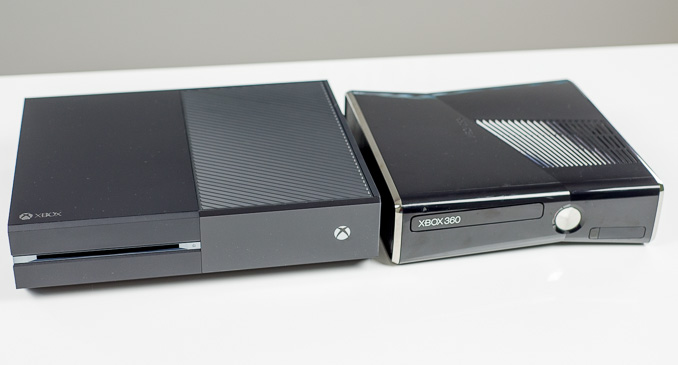
Earlier this morning Microsoft lifted the embargo on press reviews of the Xbox One. I’ve been playing with final hardware and near final software for a few days now and I wanted to share some thoughts. This is by no means one of our usual thorough review jobs, just a side quest I found myself on over the past few days.
I like the look of the Xbox One. I wish it felt a little more durable, but perhaps that’s the mobile side of me speaking where materials are a bigger deal. Sitting on a stand, desk or rack from across the room the One looks clean, simple and honestly, it looks like an Xbox. The Xbox 360 was a journey into a weird sort of industrial design that was a significant departure from the original. The past couple of revisions of the 360 have moved towards sharper angles and away from the curves of the original 360. The One completes the journey back to its roots. Dare I say it almost looks like a PC, and if you crack open the chassis you’ll be reminded of the same.
I’ll start with IO on the sides and back. There’s a single USB 3.0 port on the left side of the chassis, with two more on the rear of the machine. Support for external storage is apparently on its way, as the Xbox One doesn’t allow end user upgrades of the internal 500GB hard drive. I have to say that I prefer Sony’s stance on this one.
Gigabit Ethernet and dual-band 802.11n WiFi handle Internet connectivity. I’m still shocked that the PS4 shipped with 2.4GHz only WiFi in 2013. On the AV front there’s an optical output and HDMI in/out. Kinect has its own port on the rear of the chassis and there’s an IR port as well. There’s a Kensington security slot to the right of all of the IO on the Xbox One.
The ring of light from the Xbox 360 is gone and replaced with a single, white, backlit Xbox logo on the front of the console. You’ll notice the controller position indicators are gone as well (not only from the One, but from the controllers themselves). A combination of the Kinect camera that comes with every Xbox One and IR transceivers in every controller is all you need to figure out player/controller mapping. Indeed, the Xbox One can actually log you into your appropriate Xbox Live account based on recognizing your face alone. I set the One up at my work area, so I had to awkwardly position my face in front of the Kinect camera to make the auto login work but if you’ve got a more normal setup I can see this being supremely convenient. If you live in a household with multiple Xbox users, the facial login will be one of the standout features of the new console. There’s a quick training process that you have to go through to have the console recognize your face, but after that I never had any issues with using my face to log me in. As long as I was sitting in front of the Kinect camera, I sort of forgot about needing to log in, it always just happened for me.
It’s very obvious to me that proper cooling and quiet operation were top priorities for the Xbox One. Big portions of the One’s top are covered in vents to provide air for the large fan inside. Plastic grills adorn the sides as well. The One is larger than the PlayStation 4, despite having a lower system TDP, but the chassis size is designed to keep the internals cooler and the system quieter. It’s a tradeoff we’ve seen time and time again. While I do appreciate the PS4’s size and fully expected the Xbox One to seem huge, it absolutely doesn’t in practice.
I won’t talk too much about the Xbox One’s HDMI input. I cut the cord a few years ago, so I’m not really in the best position to comment on cable TV set-top box integration with the Xbox One. What I will say is the One’s HDMI input can really be used for anything. In testing the One, I actually had my PS4 plugged in to the HDMI input and could quickly switch between consoles simply by saying “Xbox Watch TV”. The HDMI input properly (read: legally) handles HDCP content, so by default you can’t use it to circumvent the HDCP protection that’s enabled on the PS4 at launch unfortunately. The One’s HDMI output only applies HDCP to content that needs it. The dashboard, most apps and games stream through unencrypted. Unlike the PS4, the Xbox One does not support HDMI-CEC, relying instead exclusively on IR blasting to turn on your TV and cable box (if applicable).
Kinect and voice control are big parts of the Xbox One experience. Since every Xbox One comes with a Kinect in the box, developers can count on a 3D camera and always-on mic whenever they sell to an Xbox One customer. The early titles that I’ve played don’t really do a great job leveraging either of these things, but I suspect we’ll see some clever use cases in the future. I’ve never been a big Kinect user, but I did use the Xbox One’s voice control quite a bit. Just to set expectations, voice interaction with the Xbox isn’t as natural as what you’d see on an episode of Star Trek: TNG, but it’s not bad either. I found myself using voice as an augmentative interface rather than something I replaced the controller with. In fact, I typically used voice control as another pair of hands to deal with the Xbox One’s UI while I’m off doing something else. For me it was always quicker to hit the Xbox button to go home rather than telling the Xbox to go home, but for things like recording a clip of the last 30 seconds of gameplay the voice integration is irreplaceable. More than a few times I’d be particularly proud of something I did in Killer Instinct or Call of Duty, call out Xbox, record that, and it would immediately dump the last 30 seconds of gameplay into a temporary buffer. All of this would happen with no impact to game frame rate or performance. I’d just have to remember to go back into the Game DVR and actually save/commit these recordings otherwise they’d eventually be overwritten if I kept going. Unfortunately Microsoft’s Upload studio, the application needed to share these recordings, won’t be available until the official launch of the console so we’ll have to wait and see how all of that turns out.
I feel like we’re heading in the right direction as far as voice recognition goes, but we’re not quite there yet. The voice integration on the One still feels awkward and doesn’t make good use of natural, conversational language. I don’t want to feel like I’m issuing commands to my console, I want to sort of ask it to do things for me in whatever way I want and to have it respond accordingly. Hey Xbox, start downloading Dead Rising 3 and I want to play Battlefield 4 in the meantime - get me there and we’re in business.
One feature I absolutely loved using the Kinect camera for was to read QR codes to activate downloads in the Xbox Store. Recognition is extremely quick and it keeps me from having to type on the miserable on-screen keyboard (with no word suggestions like the PS4 nonetheless).
Those concerned about their privacy will be happy to know that Kinect isn’t required for use. You can boot the console and use it just fine even if you never connect Kinect. While at the dashboard you will get a little message telling you that Kinect is unplugged however.
The UI and Multitasking
The Xbox UI is much improved over its predecessor. Multitasking is no longer a painful endeavor. You can quickly move between playing a game, changing settings or even messing around with other applications. If anything, the most visible feature of the next-generation of game consoles is just how much better multitasking is. On the Xbox 360 if you wanted to mess around with any console settings while in a game you’d have to physically quit the game, and in some cases even log out of Xbox Live. With the One it’s all a matter of suspend and resume. It’s quick, unobtrusive and tremendously less frustrating.
Multitasking is also far less of a performance hog than on the 360. For starters the One has a ton of x86 cores to handle multitasking (8 total, I believe 2 of which are dedicated to OS work), and it’s now running two independent OSes with a hypervisor managing both. The results are quite evident. If you’re coming from a 360, you’ll appreciate better graphics in games today, but you’ll probably love the fact that you no longer have to fight the UI as much.
It’s not all roses though. I can definitely get the UI to drop frames, particularly when using the One’s new snap feature that lets you display two things on the screen at once. GPU power is time sliced between the the Windows kernel and Xbox OS (10% allocated to the Windows kernel). Microsoft hopes to eventually offer that remaining 10% up to game developers as well, but we’re not there yet. The time slice is quite obvious when you’re playing a game and Xbox notifications slowly animate at the bottom of the screen. When things do get sluggish however, the One mostly seems to drop UI frames and avoids increasing response time. I always dreaded doing anything while playing a game on the 360, the same is no longer true on the One.
The Xbox One’s UI isn’t always incredibly straightforward either. It’s good that Microsoft has been able to so quickly embrace and deploy a common UI across all platforms, but I’m not sure that it’s necessarily the best UI out there. There’s a large horizontal list of tiles, reminiscent of Windows 8. You can pin individual tiles to the left side of the dashboard, and depending on what screen you’re in the order of the tiles may vary depending on what you’ve done most recently. Transitions between tiles are also a bit odd. I expect to go into a tile when I select it, but in most cases the display will scroll up, transitioning to a new “window” when I activate a tile. The other thing I’d say is the tiled interface isn’t particularly pretty. Go into the movie, music or game stores and you get these beautifully integrated photos and artwork, but the bulk of what you stare at in the Xbox One UI are big blocks of color. I would’ve loved to have seen a more dramatic reimagining of what this could be (although it’s still worlds better than the Xbox 360’s UI).
The Controller
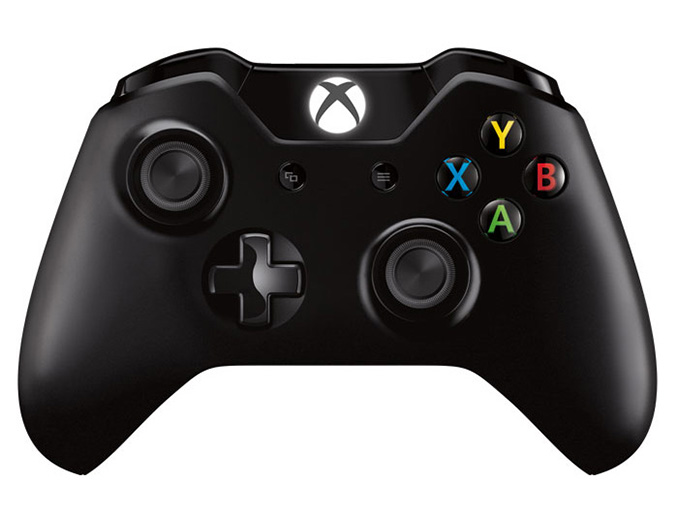
The Xbox One supports up to 8 wireless controllers, one of which is included in the box. By default the controllers take two AA batteries, although Microsoft will offer optional first party rechargeable batteries at launch. I didn’t get time to build a good battery life test for the One’s controllers, but Microsoft tells me you should expect somewhere around 30 hours of use on a single set of AAs.
The new controller is a clear evolution of the 360’s controller. There are three features that stood out to me in using the controller. For starters, the amount of initial resistance in each thumbstick has been dialed back considerably. The new thumbsticks are easier to use and less fatiguing as a result. Secondly, the new d-pad ditches the silly old platform that the old d-pad rested on. Instead you get a standard plus-arrangement. Each direction is accompanied by a shallow but pronounced click. It’s great for using the d-pad for issuing commands, but for fighting games I’d prefer something a little softer rather than discrete clicks. I feel like Microsoft likely picked the right tradeoff here as the days of Street Fighter, Mortal Kombat and Killer Instinct are long behind us, despite the latter making another appearance on the One.
The final improvement to the controller is the inclusion of what Microsoft is calling impulse triggers. The One’s controller features a total of four vibrating motors, one in each grip and one in each of the two big triggers (LT/RT). For games that choose to implement it, impulse trigger support is awesome. You get a subtle rumble that’s very focused on the triggers rather than your whole controller vibrating like crazy. I feel like force feedback in controllers is obviously here to stay, but it’s rarely used in a particularly subtle fashion. Instead what you normally run into is short bursts of feedback or long, agonizing vibration. NBA 2K14 appears to use the impulse triggers and the result is something in between, and something I really did appreciate.
For the first time since the introduction of the Xbox, Microsoft has done away with the back/start buttons and instead replaced them with view and menu buttons. They more or less serve the same functions, it’s just interesting to me how every major generation we come across an obvious desire to ditch select/start.


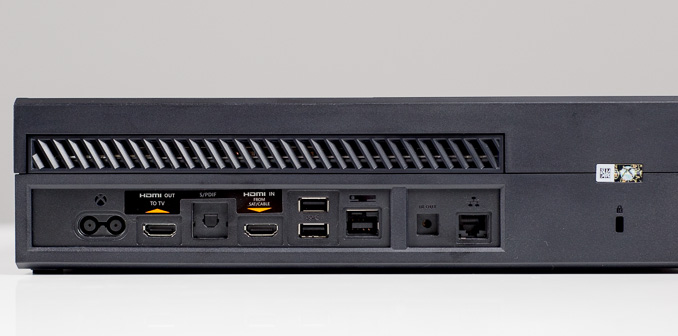
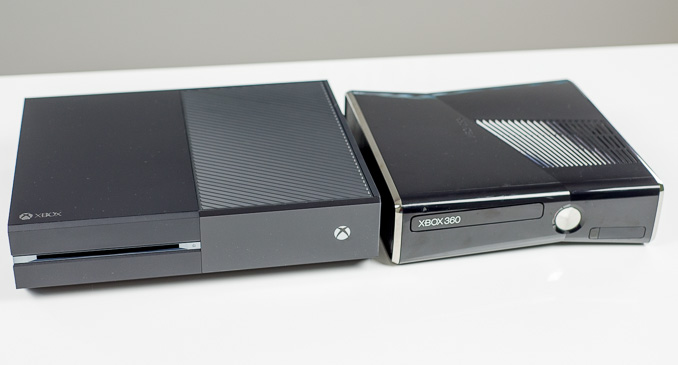






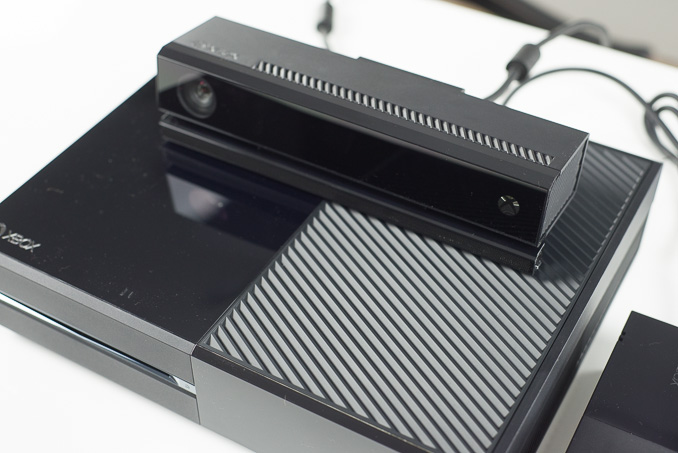








286 Comments
View All Comments
nathanddrews - Wednesday, November 20, 2013 - link
Nice article, thanks for posting!Will you be going into any of the media streaming capabilities of the different platforms? I've heard that Sony has abandoned almost all DLNA abilities and doesn't even play 3-D Blu-ray discs? (WTF) Is Microsoft going that route as well or have they expanded their previous offerings? Being able to play MKV Blu-ray rips would be interesting...
Also, what's the deal with 4K and HDMI? As I understand it, the new consoles use HDMI 1.4a, so that means only 4K at 24Hz (30Hz max), so no one is going to be gaming at 4K, but it would allow for 4K movie downloads.
I've spent the last couple years investing heavily into PC gaming (Steam, GOG, etc.) after a long stint of mostly console gaming. A lot of my friends who used to be exclusive console gamers have also made the switch recently. They're all getting tired of being locked into proprietary systems and the lack of customization. I've hooked a bunch of them up with $100 i3/C2Q computers on Craigslist and they toss in a GTX 670 or 7950 (whatever their budget allows) and they're having a blast getting maxed (or near maxed) 1080p gaming with less money spent on hardware and games. Combined with XBMC, Netflix via any browser they prefer, it's definitely a lot easier for non-enthusiasts to get into PC gaming now (thanks big Picture Mode!). Obviously, there's still a long way to go to get the level of UI smoothness/integration of a single console, but BPM actually does a pretty good job switching between XBMC, Hyperspin, Chrome, and all that.
SunLord - Wednesday, November 20, 2013 - link
A 4k movie is at least 100+GB and that just for one movie... No one sane is going to be downloading them or at least not more then 2 a month.nathanddrews - Wednesday, November 20, 2013 - link
Except they aren't 100+GB. The 4K movies Sony is offering through its service are 40-60GB for the video with a couple audio tracks. You forget that most Blu-ray video files are in the 20-30GB range, only a handful even get close to 45GB. And that's using H.264, not H.265 which offers double the compression without sacrificing PQ.Don't measure other peoples' sanity based upon your own. I download multiple 15-25GB games per month via Steam without even thinking about it. 4K video downloads are happening now and will likely continue with or without your blessing. :/
3DoubleD - Wednesday, November 20, 2013 - link
The thing is, 4k is roughly 4x the pixels as 1080p. Therefore, a 4k video the the appropriate bit-rate will be ~4x the size as the 1080p version. So yes, a 4k movie should be about 80 - 120 GB.Now the scaling won't be perfect given that we aren't requiring 4x the audio, but the audio on 1080p BRs is a small portion relative to the video.
The 60 GB 4k video will probably be an improvement over a 30 GB 1080p video, but the reality is that it is a bitrate starved version, sort of like 1080p netflix vs 1080p BR.
The thing is, what format is available to delivery full bitrate 4k? Quad layer BRs? Probably not. Digital downloads... not with internet caps. Still, I'm in no rush, my 23 TB (and growing... always growing) media server would be quickly overwhelmed either way. Also, I just bought a Panasonic TC60ST60, so I'm locking into 1080p for the next 5 years to ride out this 4k transition until TVs are big enough or I can install a projector.
nathanddrews - Wednesday, November 20, 2013 - link
When you say "full bitrate 4k", do you even know what you're saying? RED RAW? Uncompressed you're talking many Gbps, several TBs of storage for a feature-length film. DCI 4K? Hundreds of GBs. Sony has delivered on Blu-ray quality picture quality (no visible artifacts) at 4K under 60GB, it's real and it looks excellent. Is it 4K DCI? Of course not, but Blu-ray couldn't match 2K DCI either. There are factors beyond bit rate at play.Simple arithmetic can not be used to relate bit rate to picture quality, especially when using different codecs... or even the same codec! Using the same bit rate, launch DVDs look like junk compared to modern DVDs. Blu-ray discs today far outshine most launch Blu-ray discs at the same bit rate. There's more to it than just the bit rate.
3DoubleD - Wednesday, November 20, 2013 - link
You certainly know what I meant by "full bitrate" when I spent half my post describing what I meant. Certainly not uncompressed video, that is ridiculous.There is undoubtedly room for improvements available using the same codec to achieve more efficient encoding of BR video. I've seen significant decreases in bitrate accomplished with negligible impact to image quality with .264 encoding of BR video. That said, to this day these improvements rarely appear on production BR discs, but instead by videophile enthusiasts.
If what your saying is that all production studios (not just Sony) have gotten their act together and are more efficiently encoding BR video, then that's great news! Now when ripping BRs I don't have to re-encode the video more efficiently because they were too lazy to do it in the first place!
If this is the case, then yes, 60 GB is probably sufficient to produce artifact free UHD; however, this practice is contrary to the way BR production has been since the beginning and I'd be surprised if everyone follows suit. Yes, BR PQ/bitrate has been improving over the years, but not to the level of a 60GB feature length movie completely artifact free UHD.
Still, 60 GB is both too large for dual layer BRs and far too large for the current state of internet (with download caps). I applaud Sony for offering an option for the 4K enthusiast, but I'm still unclear as to what the long term game plan will be. I assume a combination of maintaining efficient encoding practices and H.265 will enable them to squeeze UHD content onto a double layer BR? I hope (and prefer) that viable download options appear, but that is mostly up to ISPs removing their download caps unfortunately.
Overall, it's interesting, but still far from accessible. The current extreme effort required to get UHD content and the small benefit (unless you have a massive UHD projector setup) really limits the market. I'm saying this as someone who went to seemingly extreme lengths to get HD content (720p/1080p) prior to the existence of HDDVD and BR. Of course consumers blinded by marketing will still buy 60" UHD TVs and swear they can see the difference sitting 10 - 15+ ft away, but mass adoption is certainly years away. Higher PQ display technology is far more interesting (to me).
Keshley - Wednesday, November 20, 2013 - link
You're assuming that all 45 GB of the data is video, when usually at least half of that is audio. Audio standards haven't changed, still DTS-MA, TrueHD, etc. Typically the actual video portion of a movie is around 10GBs, so we're talking closer to the 60GB number that was mentioned above.3DoubleD - Wednesday, November 20, 2013 - link
The video portion of a BR is by far the bulk and audio is certainly not half the data. For example, Man of Steel has 21.39 GB of video and the English 7.1 DTS HD track is 5.57 GB. The entire BR is 39 GB, the remainder are a bunch of extra video features and some extra other DTS audio tracks for other languages is also included. So keeping the bitrate to pixel ratio the same, 4x scaling gives us ~85 GB. To fit within 60GB, the video portion could only be 54.5GB to leave room for DTS HD audio (english only) That would be ~64% of the bitrate/pixel for UHD compared to 1080p, assuming 4x scaling and the same codec and encoding efficiency. Perhaps in some cases you can get away with less bitrate per pixel given the shear number of pixels, but it certainly seems on the bitrate starved side to me. Even if video without noticeable artifacts is possible for a 2h20min movie (20 min of credits, so ~2h) like Man of Steel, a longer movie or a one that is more difficult to encode without artifacts (grainy, dark) would struggle.Keep in mind, that is JUST the core video/audio. We've thrown out all the other video that would normally come with a BR (which is fine by me, just give me the core video and audio and I'm happy). If they insist on keeping the extra features on a UHD BR release, they would certainly have to include them on a separate disc since even an average length movie would struggle to squeeze to fit on a 50GB disc. To fit a BR with just video and english DTS HD audio, we are talking 52% bitrate/pixel for UHD compared to 1080p. We would certainly need .265 encoding in that case.
So I would probably concede that UHD without artifacts with only 60GB is possible for shorter films or if you can get away with less bitrate/pixel due to the higher resolution. For longer films and/or difficult to encode films, I could see this going up towards 100 GB. Putting more effort into encoding efficiency and switching to .265 will certainly be important steps towards making this possible.
Kjella - Friday, November 22, 2013 - link
For what it's worth, BluRay is far beyond the sweet spot in bit rate. Take a UHD video clip, resize to 1080p and compress it to BluRay size. Now compress the UHD video to BluRay size and watch them both on a UHDTV. The UHD clip will look far better than the 1080p clip, at 1080p the codec is resolution starved. It has plenty bandwidth but not enough resolution to make an optimal encoding. The other part is that if you have a BluRay disc, it doesn't hurt to use it. Pressing the disc costs the same if the video is 40GB total instead of 30GB and it could only get slightly better, while if you're streaming video it matters. Hell, even cartoons are often 20GB when you put them on a BluRay...ydeer - Thursday, November 21, 2013 - link
I pay 29.99 for my 150/30 Mbit connection with 3 TB of traffic. My average download volume was around 450 GB over the last few months and I sit close enough to my 60" screen (which isn’t 4k - yet) to notice a difference between the two resolutions.So yes, I would absolutely buy/rent 4k movies if sony could offer them at decent nitrate. I would even buy a PS4 for that sole purpose.